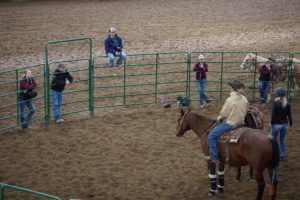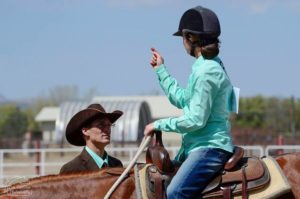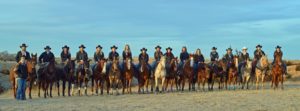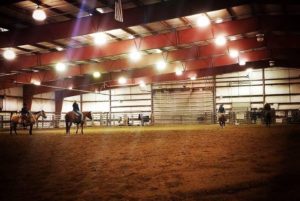
Legacy of Ranching Teaching Day
While the pandemic saw schools shut down the world over, the challenge for educators who teach an equine curriculum with a largely hands-on practical- based component has been particularly tricky. But instead of going the usual route of books and zoom classes, some professors got creative, did some research and added the expert videos of trainers on Cutting Horse Training Online /Reined Cow Horse Training Online!
For six years, Snyder has taught at Colorado State University but in the spring of 2020, CSU sent students and horses home and cancelled their annual sale due to the shutdown.The school asked all the professors to shift their teaching online. But of course, a class that is focused on handling horses is a lot more difficult to teach online than traditional subjects. So Snyder had to think outside the box.
After speaking to trainers he knew in the reined cow horse industry, Snyder was recommended to look into RCHTO and CHTO as potential resources for his students. That’s when the two websites, featuring instructional videos of world-class trainers sharing their expertise and training programs, were utilized in CSU’s ranching curriculum.
“I’ve continued to use Cutting Horse Training Online and Reined Cow Horse Training Online material, again, because I think it’s a valuable resource…it’s very eye opening and it allows them to see more than what we can expose them to at the school itself,” said Snyder.
The class structure is based around the University’s Legends of Ranching Sale in April. CSU offers a Preparation for Competition Western Class, and a colt-starting class called Sales Preparation.
The school travels with the students, when possible, to help them experience and compete at bigger shows and be exposed to the top trainers in the country. They’ve shown at the newly launched NRCHA Collegiate Invitational.
Snyder highlights videos for the students to watch that focus on the topic they are covering in class.
“The students have a number of different assignments they are asked to do that relate to the sale and to the class. A lot of their written assignments relate directly to material we need to have in place for our sale. [Such as] catalog notes and descriptions of horses…”
The students have to write their own biography to introduce themselves to prospective buyers. They are also graded in their participation in the labs and taking care of the horses.
Snyder’s students found CHTO and RCHTO very educational.

John Snyder Teaching at the Legends of Ranching Sale Day
“…I think it is so important to hear from as many people as possible because no one has the right answer. Everyone solves problems differently, and the more you expose yourself to different training styles and ideas, the better horseman you become.
“I also liked the CHTO content because they aren’t clinics. I love watching videos on youtube, but the clinicians come across like they’re selling a type of magic horsemanship, it is more of a show with rapid results for viewing pleasure. This is unlike the content in CHTO where the trainers are explaining what works for them as they are actively working on their horses. They aren’t selling a magic recipe, but they show what it actually looks like to actively ride and work your horse,” said CSU Student, Makenna. (Student names withheld for privacy reasons.)
Another student enjoyed the benefit of being able to replay videos to deepen their understanding.
“The best thing I gained was being able to watch the maneuvers in the videos multiple times to really see where the release of pressure should be for each exercise. It was also very beneficial to see the different viewpoints on things that we learned in class and be able to review some of the things we did in class to see where I could have improved and where I did things well. Finally, in some videos I enjoyed seeing an older perspective of how some things are done, like with the post method of round penning,” said Tate.
The University of Nebraska Lincoln offers multiple classes for the agriculturally inclined student. As assistant professor at UNL for nine years, Joanna Hergenreder, developed the horse training component at the school. She is the academic head of Animal Science/ Ag Education at the Nebraska College of Technical Agriculture (NCTA) which operates as part of UNL and she has advanced the equine program immensely.
 Hergenreder said the NCTA is unique in that it’s an industry-focused two year agricultural college program. They have four divisions: a veterinary technician program, agronomy and horticulture, AgriBusiness Management and Animal Science Agricultural Education.
Hergenreder said the NCTA is unique in that it’s an industry-focused two year agricultural college program. They have four divisions: a veterinary technician program, agronomy and horticulture, AgriBusiness Management and Animal Science Agricultural Education.
She said the students get an inside look at the real-life management of horses, barn operations, breeding, nutrition, genetics and other sciences.
“There was that missing piece of the handling and training and a lot of these kids really wanted that. We developed an intermediate training class and an advanced performance class to add to the colt-starting class we had when I got here,” Hergenreder said.
The program attracts students at different stages of their horsemanship journey. Most students are interested in the livestock business.
“[The program] has really grown. We have seen numbers in those classes double over the last couple years.”
The NCTA has a ranch horse team along with a rodeo team. The teams travel the country competing.
“Our school is one of the top in the country for job placement. Being small helps with that, but we also require an internship from all of the [students involved in] livestock. I think that is an important piece of the network so they have the connections for jobs before they’re done.”
She keeps the courses very practical. For example, instead of only learning about equine conformation from a book, she will have them assess live horses.
The school is a functioning business that students learn from. Horses come into the program, and the students train and sell the horses and then purchase another. The school even produced a horse named Four Sieto Gill that was reserve champion in a novice class for the American Stock Horse Association in 2015. He came to the school as a weanling and went on to show in the ranch horse classes.
Some students train horses outside of school so they can continue to develop professionally and help pay for tuition. Most students bring their personal horses so the school does not own as many as it once did.
“I feel strongly about getting [the students] ready to talk to clients. So their assessment, on a regular basis, is having to provide the client with a training report every week. For their midterm, they have to organize a 5-10 minute presentation that can walk through the progress of that horse with the client.”
“When COVID hit, I had to get creative on how I was going to demo or expose our students to the industry. I had a young lady in New York, another in Colorado, I had [students] spread all over the country.”
“The thing I really noticed the most that made me really consider incorporating [RCHTO], somehow, into our program was you got to take a test ride in their facility. And really got to see them in their element. Whereas at a clinic or in a demo setting here on campus, you don’t get those pieces. So I saw another element to what you guys where doing that could really expose the students to parts of the industry they don’t get to [experience],” Hergenreder said.
Hergenreder appreciates RCHTO as a resource so she herself can continue to professionally develop. She highlighted Randy Paul and Phillip Ralls’s post pen videos as something new that they hadn’t seen before. After watching the videos, the class had a great discussion on the concept she said.

UNL’s Heated Indoor Facility
A student wanted to breed his horse and he watched Phillip Rall’s post pen video and saw that his vest had a stallion’s name on it. It introduced this student to a whole new world of breeding and what stallions may be good to breed to.
“It’s educating them to the industry. It has been a good resource.”
CSU student Erin agreed, “I found the videos on this site to be applicable to my experience at work preparing young horses to compete in reining competitions. There were many different videos with different trainer’s perspectives that allowed me to find techniques that work for me,” he said.
Jennifer Cole of Central Wyoming College ordered the CHTO DVD collection. CWC is unique in that it offers cutting-specific classes. Cole created the classes a year ago.
“I have a very unique student population and our program requires students to bring their own horses to college. None of these students have cutting horses or horses even bred for cutting,” Cole said.
“It makes for a great learning opportunity as the students have to learn to read a cow (many of them have never even been around a cow!) and develop really good timing. Cutting creates a situation in which the rider needs to learn new skills, such as better balance, timing of their rider aids, and new training techniques, all while tying it to a cow. The cow is a wonderful teacher as the cow provides the rider with instant feedback on their timing and position,” she said.
She uses the CHTO DVDs as a resource and she shares the videos with her class during the lecture portion of her courses. The students are able to see the finished product and it helps initiate great discussion. She said that it has been fun to work with these students and their horses and share cutting with them. Not many students would get the opportunity to cut any other way.
“My students have been doing really well and most importantly, are having a lot of fun as they learn!…[The] videos have helped to get my students thinking and asking questions.”
